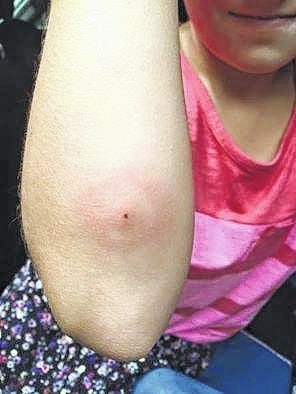
A Delaware City Council member wants to spread awareness about the dangers of Lyme disease by placing signs about ticks in city and county parks.
Council member Lisa Keller said her 9-year-old daughter, Megan, was bitten by a black-legged tick earlier this summer. A bulls-eye rash appeared on her arm, which is a sign of Lyme disease.
“What happened after that shocked me from a public health perspective,” Keller said. “Why did I have so much trouble finding a doctor who knew how to treat this?”
After receiving conflicting diagnoses, her daughter was treated by a doctor in New York City and is no longer sick, Keller said.
In addition to the rash, flu-like symptoms appear 3-30 days after a tick bite. If left untreated, Lyme disease can cause arthritis, facial paralysis and heart problems, regardless of age.
Although Keller thinks her daughter was bitten in their yard, rather than while hiking in the woods, she wants to place signs similar to the flyer in city and county parks. She said the intent is not to cause panic, but to help people make better decisions.
City Manager Tom Homan, Mayor Carolyn Kay Riggle and Preservation Parks of Delaware County executive director Tom Curtin expressed their support for the signs.
“It’s become my mission to use this experience and see if I can do anything to help keep another parent from going through this terrible process,” Keller said.
Lyme disease has been spreading eastward since it was first reported in Old Lyme, Connecticut, in 1975.
“It is becoming a little more common here,” said Travis Irvan, epidemiologist for the Delaware General Health District, who spoke at the City Council meeting on Monday. “There used to be 2-3 cases a year, and there’s six cases so far this year.”
Formerly known as the deer tick, the black-legged tick can be as small as the period at the end of this sentence.
“We never found the tick, but we found the rash,” Keller said.
Tick bites peak in the summer, but can occur anytime.
“They are active year-round,” said health district program manager Adam Howard. “They’re hardy little guys.”
“Most cases are caused by immature ticks called nymphs, which are very small and may go unnoticed, even when biting,” states an Ohio Department of Health fact sheet. “Ticks must be attached for 24 hours or more before the Lyme disease bacteria are passed.”
The Delaware General Health District has issued a “Check for ticks” flyer with the acronym TICKS, which stands for:
• Treat clothing or skin with repellents.
• Inspect yourself, clothing and gear for ticks.
• Clean and disinfect any area where a tick was removed.
• Keep a record of the date the tick was removed.
• Shower or wash off as soon as possible after coming indoors.
To remove a tick, the health district flyer said: “Using tweezers, grasp tick near the skin and pull steadily until it is removed. Do not use kerosene, matches or nail polish to remove the tick. Disinfect site with soap and water.”


